2时间介词in-on-at的用法
- 格式:docx
- 大小:14.98 KB
- 文档页数:6
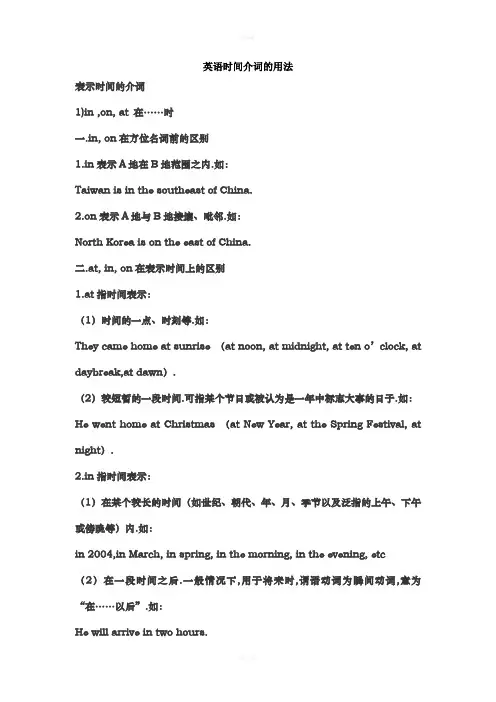
英语时间介词的用法表示时间的介词1)in ,on, at 在……时一.in, on在方位名词前的区别1.in表示A地在B地范围之内.如:Taiwan is in the southeast of China.2.on表示A地与B地接壤、毗邻.如:North Korea is on the east of China.二.at, in, on在表示时间上的区别1.at指时间表示:(1)时间的一点、时刻等.如:They came home at sunrise (at noon, at midnight, at ten o’clock, at daybreak,at dawn).(2)较短暂的一段时间.可指某个节日或被认为是一年中标志大事的日子.如:He went home at Christmas (at New Year, at the Spring Festival, at night).2.in指时间表示:(1)在某个较长的时间(如世纪、朝代、年、月、季节以及泛指的上午、下午或傍晚等)内.如:in 2004,in March, in spring, in the morning, in the evening, etc (2)在一段时间之后.一般情况下,用于将来时,谓语动词为瞬间动词,意为“在……以后”.如:He will arrive in two hours.谓语动词为延续性动词时,in意为“在……以内”.如:These products will be produced in a month.注意:after用于将来时间也指一段时间之后,但其后的时间是“一点”,而不是“一段”.如:He will arrive after two o’clock.3.on指时间表示:(1)具体的时日和一个特定的时间,如某日、某节日、星期几等.如:On Christmas Day(On May 4th),there will be a celebration.(2)在某个特定的早晨、下午或晚上.如:He arrived at 10 o’clock on the night of the 5th.(3)准时,按时.如:If the train should be on time,I should reach home before dark.三.at,in和on表示地点时的区别1.at表示地点:(1)用于指较小的地方.如:I shall wait for you at the station.(2)用于门牌号码前.如:He lives at 115 Zhongshan Road.2.in表示地点:(1)用于指较大的地方.如:He lives in Shanghai.(2)虽然是很小的地方,如果说话人住在那里,也可用in.商店、学校、机关等,若看作一个地点(point)用at,若看作一个场所(place)用in.如:I met him at the post-office.I’m now working in the post-office.3.on表示地点,一般指与面或线接触,意为“在……上;在……旁”.如:The picture was hanging on the wall.New York is on the Hudson River.口诀1:年月周前要用in,日子前面却不行。
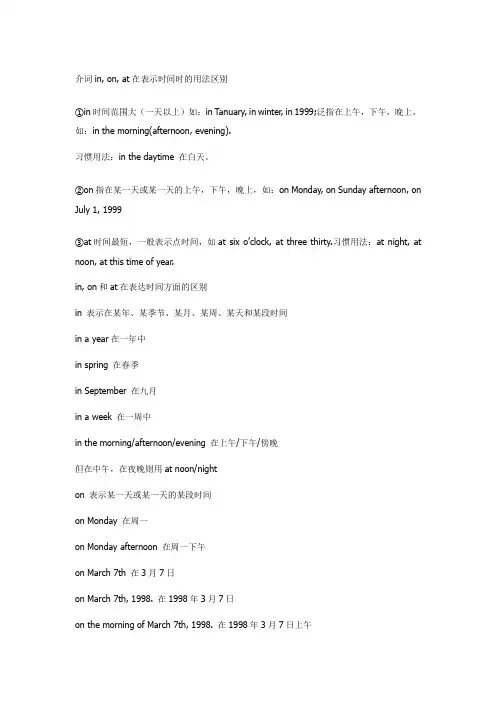
介词in, on, at在表示时间时的用法区别①in时间范围大(一天以上)如:in Tanuary, in winter, in 1999;泛指在上午,下午,晚上,如:in the morning(afternoon, evening).习惯用法:in the daytime 在白天。
②on指在某一天或某一天的上午,下午,晚上,如:on Monday, on Sunday afternoon, on July 1, 1999③at时间最短,一般表示点时间,如at six o’clock, at three thirty.习惯用法:at night, at noon, at this time of year.in, on和at在表达时间方面的区别in 表示在某年、某季节、某月、某周、某天和某段时间in a year在一年中in spring 在春季in September 在九月in a week 在一周中in the morning/afternoon/evening 在上午/下午/傍晚但在中午,在夜晚则用at noon/nighton 表示某一天或某一天的某段时间on Monday 在周一on Monday afternoon 在周一下午on March 7th 在3月7日on March 7th, 1998. 在1998年3月7日on the morning of March 7th, 1998. 在1998年3月7日上午at 表示某个具体时刻。
at eight o’clock 在8点钟at this time of the year 在一年中的这个时候at the moment 在那一时刻at that time 在那时注意:在英语中,如果时间名词前用this, last, next 等修饰时,像这样的表示,“在某时”的时间短语前,并不需要任何介词。
例如:last month, last week, this year, this week, next year, the next day, the next year 等。
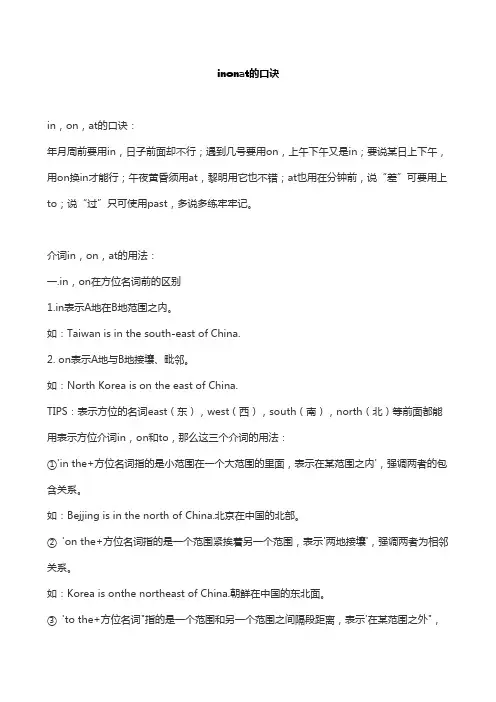
inonat的口诀in,on,at的口诀:年月周前要用in,日子前面却不行;遇到几号要用on,上午下午又是in;要说某日上下午,用on换in才能行;午夜黄昏须用at,黎明用它也不错;at也用在分钟前,说“差”可要用上to;说“过”只可使用past,多说多练牢牢记。
介词in,on,at的用法:一.in,on在方位名词前的区别1.in表示A地在B地范围之内。
如:Taiwan is in the south-east of China.2. on表示A地与B地接壤、毗邻。
如:North Korea is on the east of China.TIPS:表示方位的名词east(东),west(西),south(南),north(北)等前面都能用表示方位介词in,on和to,那么这三个介词的用法:①'in the+方位名词指的是小范围在一个大范围的里面,表示在某范围之内',强调两者的包含关系。
如:Bejjing is in the north of China.北京在中国的北部。
②'on the+方位名词指的是一个范围紧挨着另一个范围,表示'两地接壤',强调两者为相邻关系。
如:Korea is onthe northeast of China.朝鲜在中国的东北面。
③'to the+方位名词"指的是一个范围和另一个范围之间隔段距离,表示'在某范围之外",强调两者是远离关系。
如:Japan is to the east of China.日本位于中国的东边。
二. at,in,on在表示时间上的区别:at表示时间的一点;in表示一个时期;on表示特殊日子。
1. at指时间表示:at后常接几点几分,天明,中午,日出,日落,开始等。
如:at five o' clock(五点),at down(黎明),at daybreak(天亮),at sunrise(日出),at noon(中午),at sunset(日落),at midnight(半夜),at the beginning of the month(月初),at that time(那时),at that moment(那会儿),at this time of day(在一天的这个时候)。
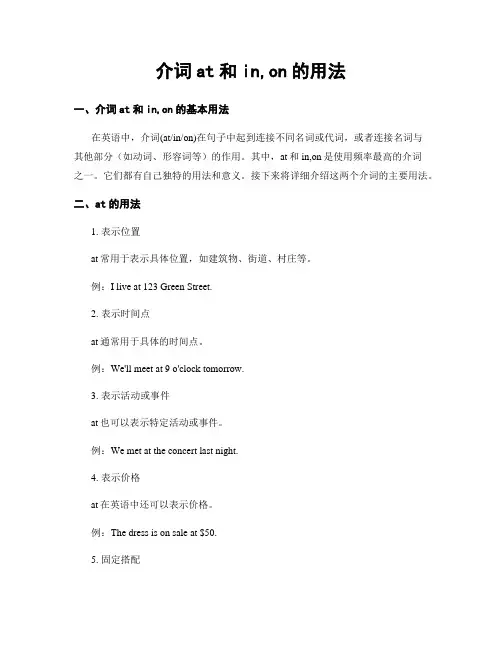
介词at和in,on的用法一、介词at和in,on的基本用法在英语中,介词(at/in/on)在句子中起到连接不同名词或代词,或者连接名词与其他部分(如动词、形容词等)的作用。
其中,at和in,on是使用频率最高的介词之一。
它们都有自己独特的用法和意义。
接下来将详细介绍这两个介词的主要用法。
二、at的用法1. 表示位置at常用于表示具体位置,如建筑物、街道、村庄等。
例:I live at 123 Green Street.2. 表示时间点at通常用于具体的时间点。
例:We'll meet at 9 o'clock tomorrow.3. 表示活动或事件at也可以表示特定活动或事件。
例:We met at the concert last night.4. 表示价格at在英语中还可以表示价格。
例:The dress is on sale at $50.5. 固定搭配at还与一些动宾结构固定搭配使用,如look at, laugh at等。
例:Don't laugh at others' mistakes.三、in的用法1. 表示位置范围in通常用于表示较大范围的位置,比如国家、城市等。
例:She lives in China.2. 表示月份/年份/季节等时间段in常用于具体的月份、年份、季节等时间段。
例:We'll go on vacation in July.3. 表示多久时间之内in也可以表示在一段时间内。
例:I can finish my work in two hours.4. 表示房间或建筑内部位置in还可以指室内的位置。
例:Please wait for me in the lobby.5. 与某些词固定搭配使用in和某些词组合使用时,有固定的搭配方式,如interested in, believe in等。
例:I'm interested in learning English.四、on的用法1. 表示接触面/表面位置on常用于描述平面接触面或表面位置。
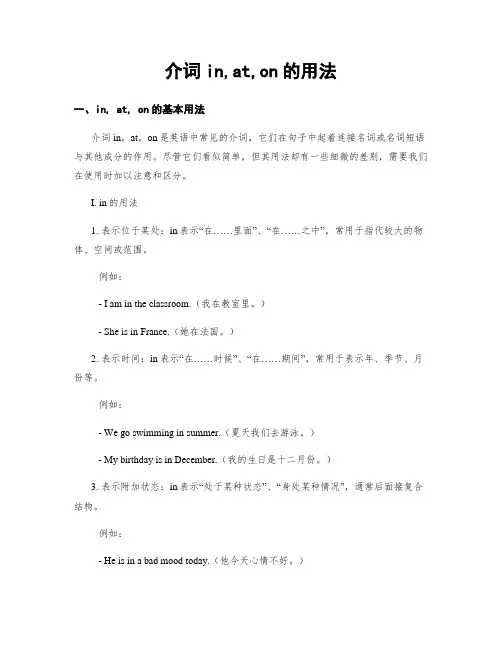
介词in,at,on的用法一、in, at, on的基本用法介词in,at,on是英语中常见的介词,它们在句子中起着连接名词或名词短语与其他成分的作用。
尽管它们看似简单,但其用法却有一些细微的差别,需要我们在使用时加以注意和区分。
I. in的用法1. 表示位于某处:in表示“在……里面”、“在……之中”,常用于指代较大的物体、空间或范围。
例如:- I am in the classroom.(我在教室里。
)- She is in France.(她在法国。
)2. 表示时间:in表示“在……时候”、“在……期间”,常用于表示年、季节、月份等。
例如:- We go swimming in summer.(夏天我们去游泳。
)- My birthday is in December.(我的生日是十二月份。
)3. 表示附加状态:in表示“处于某种状态”、“身处某种情况”,通常后面接复合结构。
例如:- He is in a bad mood today.(他今天心情不好。
)- The company is in financial trouble.(公司陷入了财务困境。
)II. at的用法1. 表示位置:at表示“在……地方”、“在某处”,常用于指代较小范围的地点、位置或具体场所。
例如:- She is waiting for you at the bus stop.(她在公交车站等你。
)- I will meet you at the cinema.(我会在电影院见你。
)2. 表示时间:at表示“在……具体时间点”,通常用于某一具体时刻、钟点或时间段。
例如:- The meeting starts at 9 a.m.(会议在上午九点开始。
)- I usually have dinner at 6:30 p.m.(我通常六点半吃晚饭。
)3. 表示动作进行的状态:at表示“正在进行某个动作”、“忙着做某事”,通常用于表示举止、动作进行中。
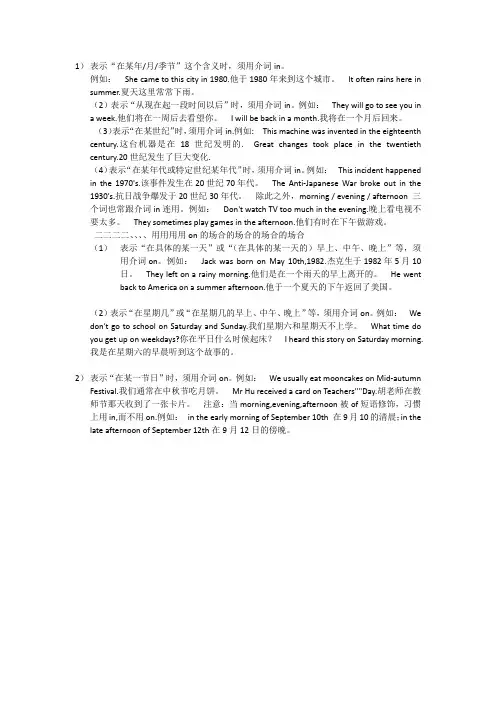
1)表示“在某年/月/季节”这个含义时,须用介词in。
例如:She came to this city in 1980.他于1980年来到这个城市。
It often rains here in summer.夏天这里常常下雨。
(2)表示“从现在起一段时间以后”时,须用介词in。
例如:They will go to see you ina week.他们将在一周后去看望你。
I will be back in a month.我将在一个月后回来。
(3)表示“在某世纪”时,须用介词in.例如: This machine was invented in the eighteenth century.这台机器是在18世纪发明的. Great changes took place in the twentieth century.20世纪发生了巨大变化.(4)表示“在某年代或特定世纪某年代”时,须用介词in。
例如:This incident happened in the 1970's.该事件发生在20世纪70年代。
The Anti-Japanese War broke out in the 1930's.抗日战争爆发于20世纪30年代。
除此之外,morning / evening / afternoon 三个词也常跟介词in连用。
例如:Don't watch TV too much in the evening.晚上看电视不要太多。
They sometimes play games in the afternoon.他们有时在下午做游戏。
二二二二、、、、用用用用on的场合的场合的场合的场合(1)表示“在具体的某一天”或“(在具体的某一天的)早上、中午、晚上”等,须用介词on。
例如:Jack was born on May 10th,1982.杰克生于1982年5月10日。
They left on a rainy morning.他们是在一个雨天的早上离开的。
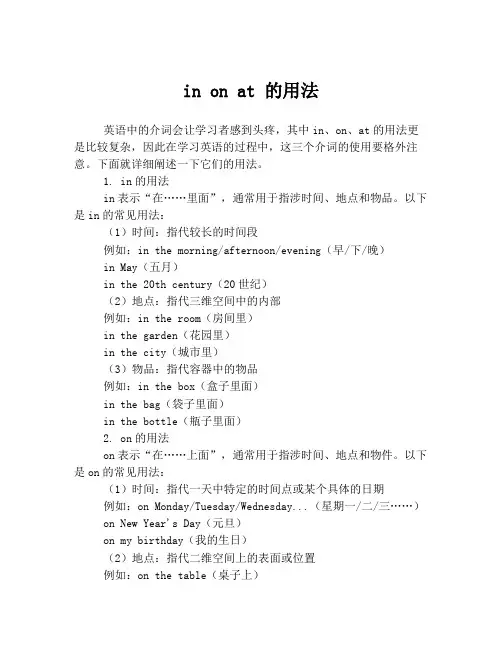
in on at 的用法英语中的介词会让学习者感到头疼,其中in、on、at的用法更是比较复杂,因此在学习英语的过程中,这三个介词的使用要格外注意。
下面就详细阐述一下它们的用法。
1. in的用法in表示“在……里面”,通常用于指涉时间、地点和物品。
以下是in的常见用法:(1)时间:指代较长的时间段例如:in the morning/afternoon/evening(早/下/晚)in May(五月)in the 20th century(20世纪)(2)地点:指代三维空间中的内部例如:in the room(房间里)in the garden(花园里)in the city(城市里)(3)物品:指代容器中的物品例如:in the box(盒子里面)in the bag(袋子里面)in the bottle(瓶子里面)2. on的用法on表示“在……上面”,通常用于指涉时间、地点和物件。
以下是on的常见用法:(1)时间:指代一天中特定的时间点或某个具体的日期例如:on Monday/Tuesday/Wednesday...(星期一/二/三……)on New Year's Day(元旦)on my birthday(我的生日)(2)地点:指代二维空间上的表面或位置例如:on the table(桌子上)on the wall(墙上)on the corner(拐角处)(3)物品:指代平面上的物品例如:on the paper(纸上)on the map(地图上)on the screen(屏幕上)3. at的用法at表示“在……上”,通常用于指涉具体位置和特殊场合。
以下是at的常见用法:(1)位置:指具体点位置的名词前例如:at the bus stop(公交站)at the office(办公室)at the cinema(电影院)(2)场合:指特殊场合或某事件发生的时间例如:at the party(聚会上)at the concert(音乐会上)at the moment(此时此刻)(3)时间:指代具体的时间点例如:at 3 o'clock(下午3点)at midnight(午夜)at dawn(黎明)以上内容,是in、on、at三个介词用法的具体细节说明,希望可以为各位学习者提供一些参考。
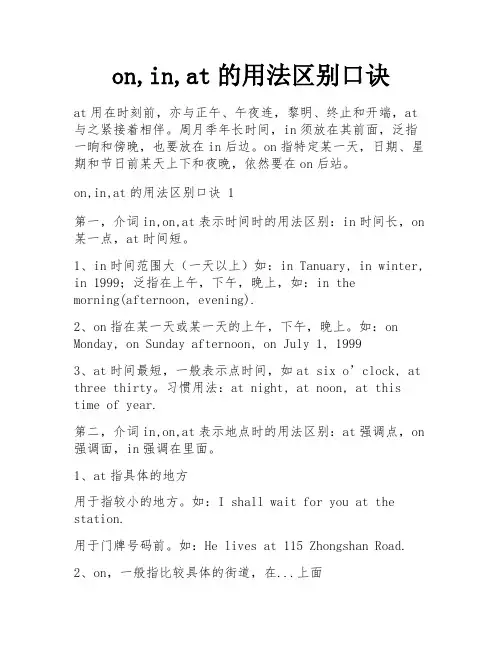
on,in,at的用法区别口诀at用在时刻前,亦与正午、午夜连,黎明、终止和开端,at 与之紧接着相伴。
周月季年长时间,in须放在其前面,泛指一晌和傍晚,也要放在in后边。
on指特定某一天,日期、星期和节日前某天上下和夜晚,依然要在on后站。
on,in,at的用法区别口诀 1第一,介词in,on,at表示时间时的用法区别:in时间长,on 某一点,at时间短。
1、in时间范围大(一天以上)如:in Tanuary, in winter, in 1999;泛指在上午,下午,晚上,如:in themorning(afternoon, evening).2、on指在某一天或某一天的上午,下午,晚上。
如:on Monday, on Sunday afternoon, on July 1, 19993、at时间最短,一般表示点时间,如at six o’clock, at three thirty。
习惯用法:at night, at noon, at this time of year.第二,介词in,on,at表示地点时的用法区别:at强调点,on 强调面,in强调在里面。
1、at指具体的地方用于指较小的地方。
如:I shall wait for you at the station.用于门牌号码前。
如:He lives at 115 Zhongshan Road.2、on,一般指比较具体的街道,在...上面如:You may know that President Obama livesonPennsylvania AvenueinWashington, D.C.3、in指的地方最大,用于指较大的地方如:He lives in Shanghai.For the best food, try the restaurantsinChinatown.虽然是很小的地方,如果说话人住在那里,也可用in。
商店、学校、机关等,若看作一个地点(point)用at,若看作一个场所(place)用in。
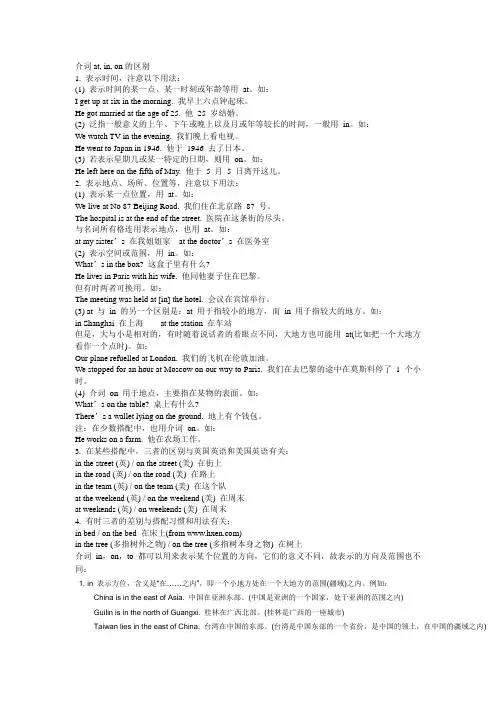
介词at, in, on的区别1. 表示时间,注意以下用法:(1) 表示时间的某一点、某一时刻或年龄等用at。
如:I get up at six in the morning. 我早上六点钟起床。
He got married at the age of 25. 他25 岁结婚。
(2) 泛指一般意义的上午、下午或晚上以及月或年等较长的时间,一般用in。
如:We watch TV in the evening. 我们晚上看电视。
He went to Japan in 1946. 他于1946 去了日本。
(3) 若表示星期几或某一特定的日期,则用on。
如:He left here on the fifth of May. 他于5 月5 日离开这儿。
2. 表示地点、场所、位置等,注意以下用法:(1) 表示某一点位置,用at。
如:We live at No 87 Beijing Road. 我们住在北京路87 号。
The hospital is at the end of the street. 医院在这条街的尽头。
与名词所有格连用表示地点,也用at。
如:at my sister’s 在我姐姐家at the doctor’s 在医务室(2) 表示空间或范围,用in。
如:What’s in the box? 这盒子里有什么?He lives in Paris with his wife. 他同他妻子住在巴黎。
但有时两者可换用。
如:The meeting was held at [in] the hotel. 会议在宾馆举行。
(3) at 与in 的另一个区别是:at 用于指较小的地方,而in 用于指较大的地方。
如:in Shanghai 在上海at the station 在车站但是,大与小是相对的,有时随着说话者的着眼点不同,大地方也可能用at(比如把一个大地方看作一个点时)。
如:Our plane refuelled at London. 我们的飞机在伦敦加油。
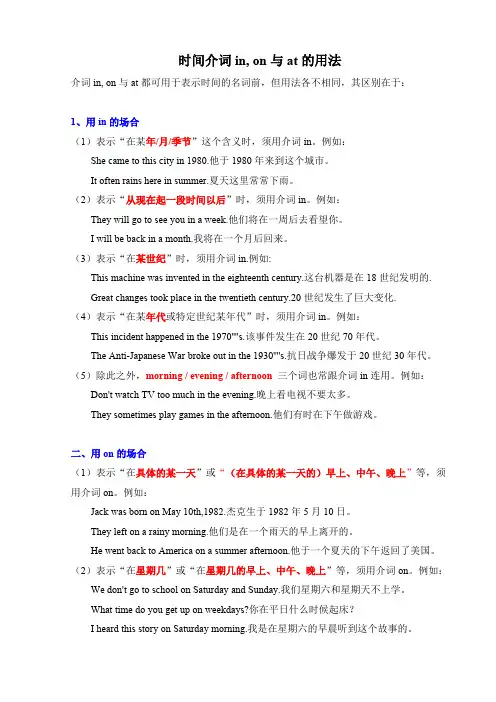
时间介词in, on与at的用法介词in, on与at都可用于表示时间的名词前,但用法各不相同,其区别在于:1、用in的场合(1)表示“在某年/月/季节”这个含义时,须用介词in。
例如:She came to this city in 1980.他于1980年来到这个城市。
It often rains here in summer.夏天这里常常下雨。
(2)表示“从现在起一段时间以后”时,须用介词in。
例如:They will go to see you in a week.他们将在一周后去看望你。
I will be back in a month.我将在一个月后回来。
(3)表示“在某世纪”时,须用介词in.例如:This machine was invented in the eighteenth century.这台机器是在18世纪发明的.Great changes took place in the twentieth century.20世纪发生了巨大变化.(4)表示“在某年代或特定世纪某年代”时,须用介词in。
例如:This incident happened in the 1970''''s.该事件发生在20世纪70年代。
The Anti-Japanese War broke out in the 1930''''s.抗日战争爆发于20世纪30年代。
(5)除此之外,morning / evening / afternoon三个词也常跟介词in连用。
例如:Don't watch TV too much in the evening.晚上看电视不要太多。
They sometimes play games in the afternoon.他们有时在下午做游戏。
二、用on的场合(1)表示“在具体的某一天”或“(在具体的某一天的)早上、中午、晚上”等,须用介词on。
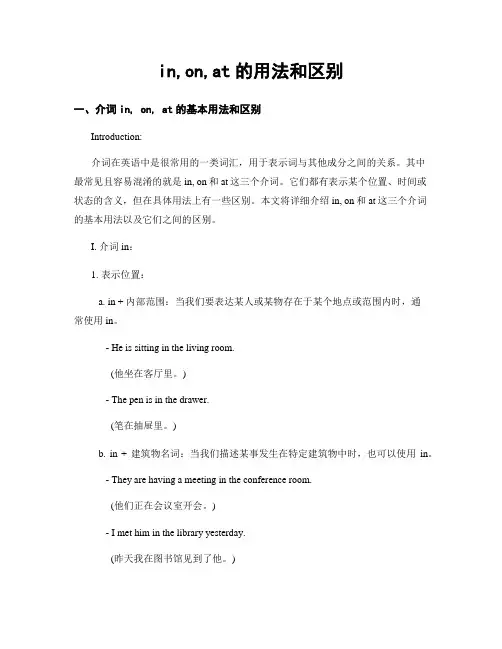
in,on,at的用法和区别一、介词in, on, at的基本用法和区别Introduction:介词在英语中是很常用的一类词汇,用于表示词与其他成分之间的关系。
其中最常见且容易混淆的就是in, on和at这三个介词。
它们都有表示某个位置、时间或状态的含义,但在具体用法上有一些区别。
本文将详细介绍in, on和at这三个介词的基本用法以及它们之间的区别。
I. 介词in:1. 表示位置:a. in + 内部范围:当我们要表达某人或某物存在于某个地点或范围内时,通常使用in。
- He is sitting in the living room.(他坐在客厅里。
)- The pen is in the drawer.(笔在抽屉里。
)b. in + 建筑物名词:当我们描述某事发生在特定建筑物中时,也可以使用in。
- They are having a meeting in the conference room.(他们正在会议室开会。
)- I met him in the library yesterday.(昨天我在图书馆见到了他。
)2. 表示时间:a. in + 年份/季节/月份/早上、下午等概括性时间段:使用in来表示较为宽泛的时间范围。
- She was born in 1990.(她出生于1990年。
)- I love to go swimming in summer.(我喜欢在夏天去游泳。
)b. in + 具体日期:当我们要指定一个具体的日期时,同样使用in。
- We have an appointment in two weeks.(我们有个在两周后的约会。
)- The seminar will be held in October.(研讨会将在10月份举行。
)3. 表示状态:a. 表示事物所处的状态或情况。
- She is in a good mood today.(她今天心情很好。
)- The project is currently in development.(项目目前还在开发中。
【导语】学习英语并不难啊。
你还在为英语成绩低拖后腿⽽烦恼吗?不要着急,⽆忧考⼩编为⼤家提供了新概念英语第2册语法:表时间的介词at、on、in的⽤法。
相信加⼊学习当中的你,很快便不再受英语的困扰!还在等什么?和⼩编⼀起来学习吧! ⼀、at 1、表⽰时刻,即⼏点⼏分(with particular points on the clock) I’ll see you at five o’clock. (我五点和你见⾯。
) 2、表⽰⼀天中的某个时间段(with particular points in the day) The helicopter took off at midday and headed for the island. (直升机中午起飞,飞往那个岛屿。
) 3、表⽰⼀周中的某个时间段,即⼯作⽇(weekday)和周末(weekend)(with particular points in the week) What are you doing at the weekend? 4、表⽰某种特殊场合,如名字中不含day的节假⽇(with special celebrations) At the New Year, millions of people travel home to be with their families(到了新年,成百上千万的⼈会回到家⾥和家⼈团聚。
) 例外情况:如果是说在⽣⽇那天,不⽤at,⽽⽤on,因为⽣⽇那天是指具体⽇期,请往下参考on的⽤法。
【注意】 如果是⽤what time来提问,what time前⾯⼀般不⽤at。
如:What time are you leaving? (你⼏点⾛?) 但是在⼝语中也可以这么问:At what time are you leaving? ⼆、on 1、⽤在⽇期前(with dates) We moved into this house on 2 October 1997. (我们是1997年10⽉2⽇搬进这栋房⼦的。
时间前面加的介词in , at,on 的差别【 in】我是“大姐”,由于我后边所接的都是较长时间。
详细用法有:1.表示在较长的时间里(如周/月份/季节/年份/世纪等)。
如:in a week; in May; in spring/ summer/autumn/ winter ; in 2008; in the 1990’s等。
2.表示在上午、下午或夜晚。
如: in the morning /afternoon /evening。
3. in the daytime (在白日)属于固定搭配,指从日出到日落这一段时间4.“ in +一段时间”表示“多久此后/之内”,常与未来时连用。
如:in halfan hour; in ten minutes; in a few days等。
【 on】我是“二姐”,我后边所接的时间多与日期相关。
详细用法有:1.表示在详细的某一天(如日期、诞辰、节日或礼拜几)。
如:on May 4th, 1919; on Monday; on Teachers ’;Dayon my birthday; on that day 等。
2.表示某一天的上午、下午或夜晚。
如:on the morning of July 2;on Sunday afternoon ; on a cold winter evening 等。
【 at】我是“小妹”,由于接在我后边的时间最短。
详细用法有: 1.表示在某一详细时辰,即几点几分。
如:at six o ’clock;athalf past nine; at a quarter to six; at this time 等。
2.表示在某一短暂的时间。
可指某个节日或被以为是一年中标记大事的日子如:at noon; at this moment ;at the end of a year;at the start of the concert ,at New Year, at Christmas等。
一. in,on在方位名词前的区别1. in表示A地在B地范围之内。
如:Taiwan is in the southeast of China.2. on表示A地与B地接壤、毗邻。
如:North Korea is on the east of China. ※二. at, in, on在表示时间上的区别1. at指时间表示:(1)时间的一点、时刻等。
如:They came home at sunrise (at noon, at midnight, at ten o’clock, at daybreak, at dawn).(2)较短暂的一段时间。
可指某个节日或被认为是一年中标志大事的日子。
如:He went home at Christmas (at New Year, at the Spring Festival, at night).2. in指时间表示:(1)在某个较长的时间(如世纪、朝代、年、月、季节以及泛指的上午、下午或傍晚等)内。
如:in 2004, in March, in spring, in the morning, in the evening, etc(2)在一段时间之后。
一般情况下,用于将来时,谓语动词为瞬间动词,意为“在……以后”。
如:He will arrive in two hours.谓语动词为延续性动词时,in意为“在……以内”。
如:These products will be produced in a month.注意:after用于将来时间也指一段时间之后,但其后的时间是“一点”,而不是“一段”。
如:He will arrive after two o’clock.3. on指时间表示:(1)具体的时日和一个特定的时间,如某日、某节日、星期几等。
如:On Christmas Day(On May 4th), there will be a celebration.(2)在某个特定的早晨、下午或晚上。
时间介词(a t,i n,o n)的用法1.at(1)时间的一点、时刻等。
如:Theycamehomeatseveno’clock.(atnight,atnoon,atmidnight,atteno’clock,atdaybreak,atdawn).(2)后面接表示岁数的词。
ChildreninChinastartschoolat6yearsold.(3)较短暂的一段时间。
可指某个节日或被认为是一年中标志大事的日子。
如:HewenthomeatChristmas(atNewYear,attheSpringFestival).2.in(1)在某个较长的时间(如世纪、朝代、年、月、季节以及泛指的上午、下午或傍晚等)内。
如:in2004,inMarch,inspring,inthemorning,intheevening,etc(2)在一段时间之后,常用于将来时。
Hewillarriveintwohours.Theseproductswillbeproducedinamonth.3.on(1)具体的时日和一个特定的时间,如某日、某节日、星期几等。
如:OnChristmasDay(OnMay4th),therewillbeacelebration.(2)在某个特定的早晨、下午或晚上。
如:Hearrivedat10o’clockonthenightofthe5th.(3)准时,按时。
如:Ifthetrainshouldbeontime,Ishouldreachhomebeforedark.表示频率的副词用法详解一、常见的频率副词always,usually,often,sometimes,seldom,never.1)always表示的频率为100%,意思是"总是、一直、始终"。
IalwaysdomycleaningonSundays.我总是在星期天搞卫生。
2)usually与always相比,表示的频率要低些,约为70%-80%。
拓展知识:巧记时间介词at,in,on的用法at用在时刻前,亦与正午、午夜连,黎明、终止和开端,at与之紧接着相伴。
周月季年长时间,in须放在其前面,泛指一晌和傍晚,也要放在in后边。
on指特定某一天,日期、星期和节日前某天上下和夜晚,依然要在on后站。
今明昨天前后天,上下这那每之前,at、in、on都不用,此乃习惯记心间。
on,at,in这三个常用介词都可以表示时间和地点,但具体用法不同,多数学生对它们混淆不清。
现在只要记住了口诀,就可避免at,on,in的种种误用。
1. on,in,at表示时间on“在具体某一天”①“当某时”,动名词,arrival,death前;early,late位句先②,用in一般“上”“下”“晚”;on用于天,in用于月、季、年③;限定三时in要变。
④at是个时间点,“工作”“时刻”与“圣诞”⑤。
at noon(night),in the day,习惯用语记心间。
注:①on表示在具体某一天及具体某一天的上午、下午和晚上。
例On mother's Day, we should send flowers to our mother. 母亲节,我们应该送花给我们的母亲。
On my arrival home,I found he had gone already.当我到家时,我发现他已经走了。
②当early,late用于句首修饰介词短语时,尽管表示具体某一天的上午、下午、晚上,都要用in,泛指一般的上、下午,晚上也用in 。
例Early in the morning of National Day,I got up to catch the first bus to the zoo.国庆节一清早,我便起床去赶到动物园的第一班公共汽车。
My father begins work at 8:00 in the morning and stops work at 4:00 in the afternoon.我父亲上午8点上班,下午4点下班。
时间介词in on at的用法
时间介词 "in," "on," 和 "at" 在英语中用于表示时间,但它们的用法有所不同。
以下是它们的一般用法:
1. "In":
- 用于表示较长的时间段,例如月份、季节、年代等。
- 例子:in May(五月)、in summer(夏季)、in the 1990s (在1990年代)。
2. "On":
- 用于表示特定的日期、星期几或节日。
- 例子:on Monday(星期一)、on July 1st(7月1日)、on Christmas Day(圣诞节)。
3. "At":
- 用于表示具体的时刻或钟点。
- 例子:at 3 o'clock(3点钟)、at noon(中午)、at midnight(午夜)。
注意一些特殊用法:
- "In" 还可用于表示将来某一时刻,如 in a few days(几天后)。
- "On" 也可用于表示某一天的早上或下午,如 on Monday morning(星期一早上)。
- "At" 通常用于具体的时刻,但也可用于特定的时间点,如at sunrise(日出时)、at sunset(日落时)。
这些规则是一般性的指导,但有时具体情境和用法可能会有例外。
因此,在学习时最好结合语境多做例句练习,以更好地理解和掌握这些介词的用法。
介词in on at 表示时间的用法及区别
Step1 Teaching Aims
教学生掌握时间介词in,on和at的区别及用法。
Step2 Teaching Key and Difficult Points
教学生掌握时间介词in,on和at的区别及用法。
Step3 Teaching Procedures
1.用in的场合后所接的都是较长时间
(1)表示“在某世纪/某年代/特定世纪某年代/年/季节/月”这个含义时,须用介词in
Eg: This machine was invented in the eighteenth century. 这台机器是在18世纪发明的。
She came to this city in 1980. 他于1980年来到这个城市。
It often rains here in summer. 夏天这里常常下雨。
(2)表示“从现在起一段时间以后”时,须用介词in。
(in+段时间表将来)
Eg: They will go to see you in a week. 他们将在一周后去看望你。
I will be back in a month. 我将在一个月后回来。
(3)泛指一般意义的上、下午、晚上用in, in the morning / evening / afternoon
Eg: They sometimes play games in the afternoon. 他们有时在下午做游戏。
Don't watch TV too much in the evening. 晚上看电视不要太多。
(4)A. 当morning, evening, afternoon被of短语修饰,习惯上应用on, 而不用in.
Eg: on the afternoon of August 1st
B. 但若前面的修饰词是 early, late时,虽有of短语修饰,习惯上应用in, 而不用on.
Eg: in the early morning of September 10th 在9月10的清晨;
Early in the morning of National Day, I got up to catch the first bus to the zoo. 国庆节一清早,我便起床去赶到动物园的第一班公共汽车。
2.用on的场合后所接的时间多与日期有关
(1)表示“在具体的某一天”或(在具体的某一天的)早上、中午、
晚上”,或“在某一天或某一天的上午,下午,晚上”等,须用介词on。
Eg: Jack was born on May 10th, 1982. 杰克生于1982年5月10日。
They left on a rainy morning. 他们是在一个雨天的早上离开的。
He went back to America on a summer afternoon. 他于一个夏天的下午返回了美国。
(2)表示“在星期几”或“在星期几的早上、中午、晚上”等,须用介词on。
Eg: We don't go to school on Saturday and Sunday. 我们星期六和星期天不上学。
What time do you get up on weekdays? 你在平日什么时候起床?
I heard this story on Saturday morning. 我是在星期六的早晨听到这个故事的。
【温馨提示】“在周末”: at weekends, on weekends. “在工作日”是 on weekdays on the weekend, at the weekend加了定冠词the, 是特指的那个周末,表示某个固定的周末;
on weekends, at weekends是一般性的每个周末。
(3)表示“在某一节假日、生日”时,须用介词on。
Eg: on my birthday
Mr Hu received a card on Teachers' Day. 胡老师在教师节那天
收到了一张卡片。
We usually eat mooncakes on Mid-autumn Festival. 我们通常
在中秋节吃月饼。
【温馨提示】 at, on都可用来表示“节假日”,但at侧重指“休
假的时节”,而不是指具体的哪一天;on侧重指具体的时日,与它
连用的短语中多含“Day” at New Year(在新年期间)
at Christmas (在圣诞节期间) on New Year’s Day(在元旦那天) on Christmas Day (在圣诞节)
3.用at的场合后接的时间最短
(1)表示“某一具体时刻(即几点几分时)”时,用于钟点时刻前,
须用介词at。
Eg: at ten o’clock, at a quarter to six
He gets up at six o'clock every day. 他每天六点起床。
I got home at five thirty yesterday afternoon. 我昨天下
午五点半到家。
(2)用在特定的时候(时节、时机)时,须用介词at, 表示一瞬间
或短暂的时间
Eg: They were happy at that time. 他们那时很幸福。
I think the shop is clcsed at this time of day. 我认为商
店在白天的这个时候关门了。
at that moment(在那一瞬间) at that time(那时)
(3)用于表示进餐时间。
Eg: at breakfast/lunch/supper (在早餐时/午餐时/晚餐时)
He drinks tea at breakfast. 他在早餐时饮茶。
(4)表示“在……岁”时,须用介词at。
Eg: At the age of nine ,the boy could swim well.在九岁的
时候,这孩子就游泳游得很好了。
(5)表示“在中午、在夜晚、在周末”时,须用介词at。
Eg: at noon /night /midnight (半夜), at sunrise (日出时) at dusk (黄昏), at dawn /daybreak (黎明)
What do you often do at noon? 你中午经常做些什么?
You can see many stars in the sky at night. 夜晚你能看到
天空中有许多星星。
Step4.Practice
Step5 Homework
Write 5 sentences with in,on and at.。